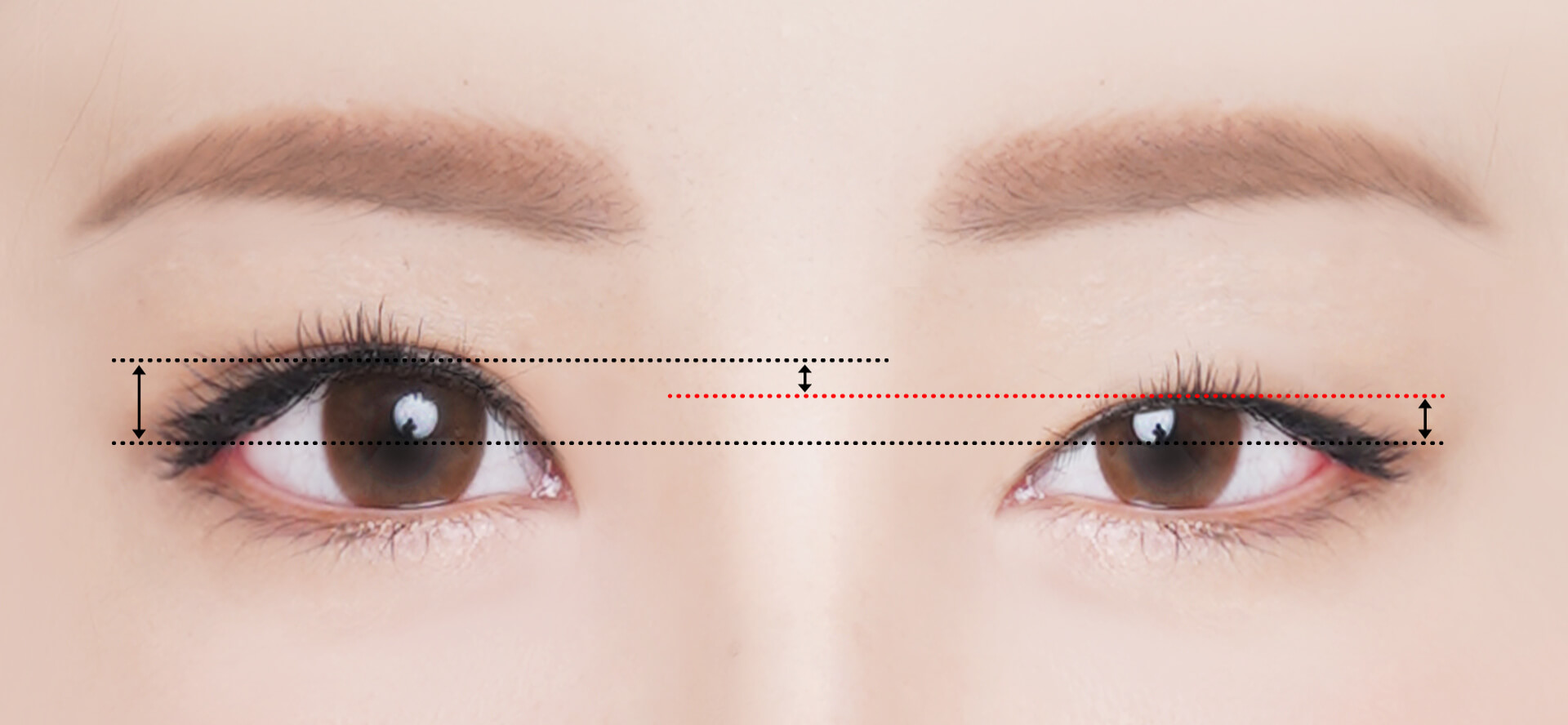Sometimes, there’s just no way around it. We want to ignore it but it’s right there when we look in the mirror. What’s worst, everyone else notices it too.
Your eyes are a reflection of your spirit.
Yes, we are talking about having droopy eyelids. It sucks to have sleepy eyes, especially if you’re born with it. And as we age, these droopy eyelids trigger more forehead wrinkles and deteriorate visions. The struggle is real.
There isn’t a way to prevent it from happening at all. But we can treat it when it happens. And we should treat it immediately before it worsens.
If you have droopy eyelids or sleepy eyes, chances are, you have ptosis. And one of the best way to fix it is by having ptosis correction surgery. Here’s what ptosis correction surgery is all about, its procedure, benefits and downsides.
What is ptosis (droopy eyelids)?
Ptosis refers to a condition where your upper eyelids droop due to muscle problems and it can happen to one or both eyes. This drooping occurs as the muscles used for raising and lowering your eyelids weakens.
Sometimes, it’s barely noticeable so we live thinking we don’t have it. Other times, it is so obvious and severe to the point that it affects how you look and blocks your vision.
What causes ptosis?
While ptosis is more often caused by aging, it can also be due to:
- Excessive eye rubbing and prolonged contact lens use
- Having a lot of excess skin on your eyelid
- Side effect of cataract, lasik surgery etc.
- Side effect of botox
- Stroke, cancer, brain tumor, muscle diseases etc.
For those born with ptosis, surgery can wait till age 3 or 4, unless it’s severe, in which case, surgery might be needed immediately.
Do I have ptosis?
Droopy eyelids, sleepy eyes or lazy eyes – these are surefire indications that you need ptosis correction surgery. But if you are still unsure whether you have ptosis or not, here are some pointers for you:

You definitely have ptosis when:
- Your upper eyelid is covering at least 1/3 of your pupil
- You are using your eyebrow and forehead muscles to open your eyes
- You often have to tip your head back and lift their chin to see better
- Your peripheral vision is blocked due to sagging eyelids
- You have lazy or sleepy eyes and cannot fully open your eyes
Other symptoms of ptosis:
- Dry or watery eyes
- Persistent aching in and around the eyes
- Having forehead wrinkles which are caused by habitual eyebrow raising
And oh, if you find any of your eyelids drooping much, especially when it seems to have appeared overnight, do seek a doctor’s advice asap as it could be a symptom of a serious nerve or muscular disease.
How to fix ptosis? And should I fix it?
If you have ptosis, even if it’s mild ptosis, but haven’t gotten treated, now is the time! Any further delay and you will end up with a lifetime of poor vision and dozens of wrinkles. Seriously!
And yes, there are non-surgical treatments for ptosis correction but you should know that those are just temporary fixes and does not actually fix your muscle issues.
So, if you really want to fix it, the most effective and best option is to get ptosis correction surgery. But while ptosis correction is usually permanent, the condition can recur because of the natural aging process.
How is ptosis correction surgery done?
Ptosis correction surgery aims to correct weak eyelid muscles. And there are 2 methods used for ptosis correction surgery in Korea – non incision and incision method.
1. Incision ptosis correction method

First, the surgeon makes an incision on the upper eyelids to access weak eyelid muscles and tissues. Then they are shorten, tighten and strengthen. And it’s done!
Honestly, the best way to fix ptosis is by incision ptosis correction method. Because it allows the surgeon to see muscles moving within the eye and choose the best fixing point.
And when coupled with double eyelid surgery, ooof, the results are #eyesonfleek.
Benefits:
- Gets rid of droopy eyelids and open your eyes
- Fix sleepy eyes and uneven eyes
- Removes excess skin on eyelid
- Fix blocked visions
- Prevents wrinkles caused by habitual squinting and eyebrow raising
Downsides:
- Minimal scarring (but scars fade over time)
- Might not be able to fully close eyes for a few weeks (due to tightened muscles)
- Condition might recur (depending on how you take care of your eyes)
2. Non incision ptosis correction method

As mentioned above in our article, non incision ptosis correction method is actually minimal incision. Because your surgeon has to access your eyelid muscles, in one way or another, in order to fix ptosis.
Sadly, non incision method is only suitable for those with mild ptosis or thin eyelids with little or no fats. Oh well.
Benefits:
- Gets rid of droopy eyelids and sleepy eyes
- Correct sleepy eyes and uneven eyes
- Fix blocked visions
- Very minimal scarring
- Prevents wrinkles caused by habitual squinting and eyebrow raising
Downsides:
- Only for people with mild ptosis and thin eyelids
- Might not be able to fully close eyes for a few weeks (due to tightened muscles)
- Condition might recur (depending on how you take care of your eyes)
How long does ptosis correction surgery take?
Ptosis correction surgery takes merely 30 mins and is performed under sedation anesthesia (no pain too) so that the surgeon can wake you to check how your eyelids look when your eyes are opened.
When can I see results?
Bruising and swelling last up to 3 weeks. Pretty accurate results can be seen after 1 month. The complete healing process takes time so final results can be seen from 6 to 12 months.
Your vision might get blurry after the surgery. Just for a few hours, relax! Also, your eyes could feel dry. So if that happens, follow your doctor’s instructions and use eye drops when necessary. Note that though ptosis correction is usually permanent, it can also recur, depending on your natural aging process and how fast your eyelid muscles deteriorates. If its recurs, you should fix it again.
Do take note that the success of your eyelid surgery not only lies in the hands of your surgeon but also how you well you recover after surgery. So learn how to properly care for yourself during the recovery period by reading our article on eyelid surgery aftercare and post-op instructions.
Actual recovery time vary among individuals, and is subjected to one’s health condition & healing response.
How long should I stay in Korea?
Ptosis correction surgery in Korea is considered a simple procedure so hospitalization is not required. But stay until your stitches are removed. And go shopping in the meantime!
Stitch removal
Stitches are usually removed 7 days after surgery.
Cautions on stitch removal
If you remove the stitches earlier then advised, you risk loosening your eyelids. And if you remove it too late, you risk further scarring and pigmentation.
Don’t rush recovery period for best results!
We know that sometimes due to time constraints, you consider removing your stitches at the local hospitals in your home country.
Although that is possible (but not recommended), it is subjected to doctor’s approval and also depends on how well you have been healing.
Non-surgical treatments for ptosis correction?
For those who don’t want surgery, non-surgical treatments such as botox are available. However, it’s not really effective, unless your ptosis condition is really mild. But then again, if you really do have mild ptosis, you should still fix it surgically before your condition worsens!
If you decide to give botox a try, do make sure your doctor is skilled and experienced. Because there have been cases of botox worsening drooping eyelids instead of treating it.
What other eyelid surgeries complements ptosis correction?
1. Double eyelid surgery
It is really common to get double eyelid surgery while getting ptosis correction surgery to make your eyes bigger and more attractive. And sometimes, just double eyelid surgery alone could also fix very mild ptosis.
2. Canthoplasty
If you want to have big yet softer looking eyes, learn how canthoplasty can help.
3. Under eye fat repositioning
If you’re also suffering from eye bags and dark circles, under eye fat repositioning is a good way to fix your eye bag issues.
4. Fat grafting surgery
Restore volume to your face to look younger than before with non-surgical fat grafting surgery.
5. Endotine forehead lift
Endotine forehead lift can lift your saggy upper face and eyebrows for a younger and more feminine look. And the best thing is that there is no scarring.
anti-aging procedureasian blepharoplastycosmetic surgery in koreaeyelid surgery in koreakorean eye surgeryplastic surgery for eyeplastic surgery in korea









What do you think?